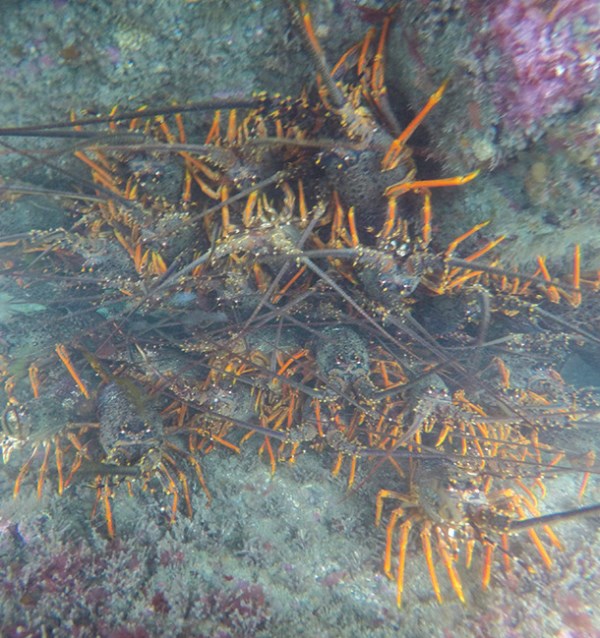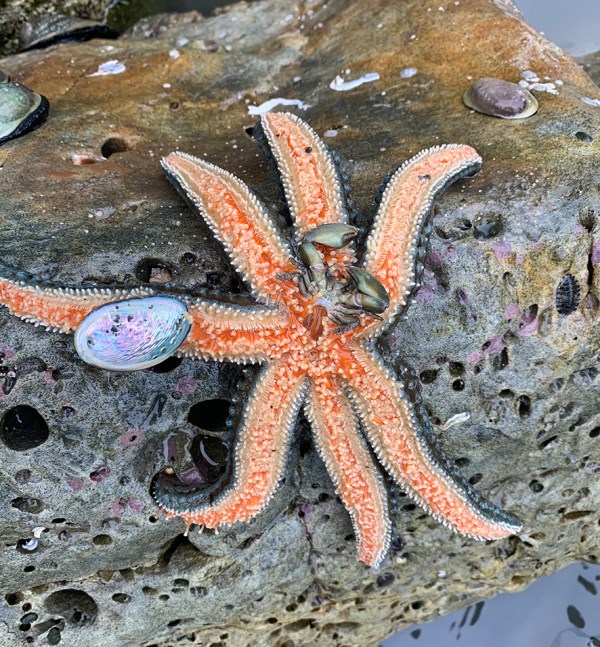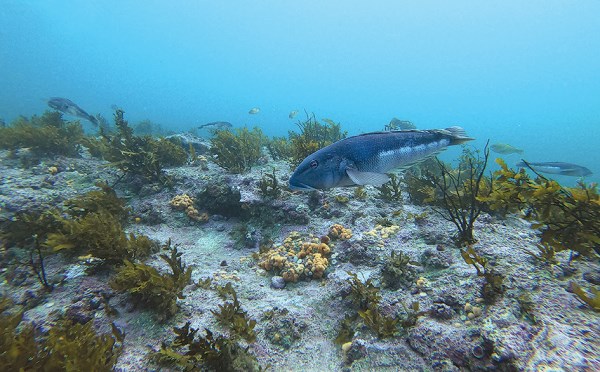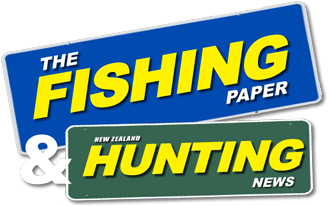
Those who are familiar with pāua from diving for them will know them as a robust, hard shelled creature, with an incredible ability to clamp down to the bottom when disturbed. This may make it hard to believe that other small marine species manage to predate on pāua.
The pāua life cycle has evolved as a survival strategy to avoid predation as much as possible, especially during the juvenile phase (when pāua are 10-80mm long). At this size pāua inhabit ‘cryptic’ habitats, meaning they are hidden under small boulders and in crevices where they can generally not be seen. The primary advantage of this is to avoid predators during this vulnerable phase. Despite this, there are still a number of predators that have devised strategies of their own to predate on pāua.

Starfish
Probably the most common and well-known pāua predator is the seven-arm starfish (Astrostole scabra). These starfish capture pāua by attaching their arms to the shell, then small tentacles release a toxin through the holes of the pāua shell to incapacitate it. After this, the starfish will sit on top of the pāua for a day or so completely devouring it, leaving only the shell.
Paua can be quite effective at escaping capture from starfish. The fastest you will ever see a pāua move is when a starfish is on the hunt in the area. If you see a pāua, while diving, that is elevated from the rock by its foot and on the move, chances are there is a starfish close by. Pāua can detect the presence of starfish by chemical signals passed through the water column, which usually gives them a head start to escape. If a starfish does get one of its arms on a pāua, it will purposefully pivot back and forwards to try and dislodge the starfish. Pāua also respond to starfish attacks by releasing small amounts of fluid (immature eggs, sperm and waste) through their respiratory pores. This has the appearance of a spawning response, however it is most likely to be an evasion response to confuse the starfish by releasing scent through the water column—similar to an octopus releasing ink to confuse predators.
Octopus
Another well documented pāua predator are the many species of octopus found in NZ waters. Octopus rely on a faster attack than the starfish to dislodge pāua before they are able to clamp down. If the first fast attack fails, octopus simply squat on the pāua and smother them by sealing respiratory pores. There is an interesting difference in the aversion response between starfish and octopus—for an octopus they will clamp down hard to the bottom, while for a starfish they lift off the rock and move away, presumably because they know they can out-run a starfish but not an octopus. If you see a group of pāua clamped down hard to the rock with rigid black skirt flared out and highly visible around the shell, there will be an octopus close by.

Fish
Some species of fish are also able to effectively predate on pāua, in particular blue cod (Parapercis colias) and banded wrasse (Pseudolabrus fucicola). In some areas it is not unusual to find small pāua shells in the guts of blue cod, which can be the bane of your sharp filleting knife! Divers will know that blue cod and wrasse will often follow them when pāua diving, hoping for an easy feed. Fish can dislodge smaller pāua from the rock surprisingly effectively by giving them a short sharp bunt with the end of their nose, after which they quickly pick away at the pāua flesh.
Crayfish and Crabs
Crayfish (Jasus edwardsii) and rock crabs (Guinusia chabrus) are also known to predate on pāua, particularly juveniles. Large crayfish can effectively dislodge pāua from the rocks using their powerful front fighter claw. It is quite common to find nests of crayfish close to patches of pāua, presumably because it means there is a potential feed for them close by.
Next time you are out diving, keep an eye out for some of these predator species and the interesting interactions that they can have with pāua. This will help you create a greater awareness of all the ecosystem interactions that support your target species, and can make it much more interesting than just filling your catch bag. For example, if you see an aggregation of pāua that are obviously in a new area away from their normal home scar, its likely they just escaped a marauding sevenarmed starfish.
It is also important to be aware of these predator interactions when releasing undersized pāua back to the reef. It is easy enough to think that if you drop a pāua from the surface back onto the rock that it will right itself head for safety, however, pāua generally land foot side up and take a while to right themselves, making them very vulnerable to predation for a time. Banded wrasse will often take few bites so that, even if the pāua rights itself, it will bleed to death later, and be finished off. Always take the extra minute to carefully place your undersized pāua back on the reef foot side down.













